PSYCHOLOGY
Paper – II
Note : This paper contains fifty (50) objective type questions of two (2) marks each. All questions are compulsory.
1. Which among the following are the products in Guilford’s structure of intellect model ?
(a) Systems (b) Transformation
(c) Reasoning (d) Interpretation
Codes :
(1) (a) and (b) only
(2) (a), (b) and (c) only
(3) (a), (b) and (d) only
(4) (a), (b), (c) and (d)
2. According to Jung, which of the following is the deepest and darkest part of collective unconscious and contains all of the animal instincts
(1) Anima
(2) Animus
(3) Shadow
(4) Persona
3. In classical conditioning progress of conditioning can be examined by indexing Conditioned Response (CR) in terms of
(a) Quantity (b) Latency
(c) Rate (d) Density
Codes :
(1) (a), (b) and (d) only
(2) (b), (c), and (d) only
(3) (a), (b), and (c) only
(4) (a), (c), and (d) only
4. Which of the following intelligence tests are applicable to an illiterate adult ?
(a) Wechsler Adult Intelligence Scale
(b) Alexander Pass Along Test
(c) Coloured Progressive Matrices
(d) Koh’s Block Design Test
Codes :
(1) (a) only
(2) (b) and (d) only
(3) (a) and (c) only
(4) (b), (c) and (d) only
5. Match List – I with List – II and select the correct answer by choosing from the codes given below :

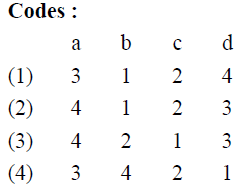
6. Length and Intensity of Lightwave play an important role in
(1) Perception of colour and brightness
(2) Perception of colour and illumination
(3) Perception of constancy and brightness
(4) Perception of brightness and illumination
7. Match List – I with List – II and select the correct answer by choosing from the codes given below :

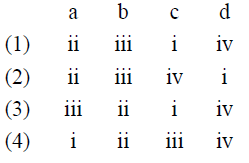
8. Geeta studied for sociology exam and then studied for psychology exam. Certain concepts and theories are similar in psychology and sociology. While taking sociology exam, she finds that she keeps getting confused with psychology theorists. Geeta’s problem is most likely due to
(1) Decay of memory trace
(2) Proactive interference
(3) Retroactive interference
(4) Encoding failure
9. Which of the following sequence is correct in case of the curve of forgetting ?
(1) Percent recall of words is greatest immediately after learning → Percent recall
decreases rapidly within the first hour → Percent recall further decreases rapidly after 30 days.
(2) Percent recall of words is greatest immediately after learning → Percent recall decreases rapidly within the first hour → Forgetting levels off after the first hour.
(3) Percent recall of words is greatest after two days → Forgetting levels off within 10 – 15 days → Percent recall decreases further after 30 days.
(4) Percent recall of words is greatest after 2 days → Percent recall decreases rapidly20 days → Forgetting levels off after 30 days.
10. Consider the following three types of investigations :
(a) Expost facto field studies,
(b) Laboratory experiments, and
(c) Field experiments,
Arrange the above three types of investigations in ascending order in terms of researcher’s ability to control secondary variance.
(1) (c), (b), (a)
(2) (b), (c), (a)
(3) (b), (a), (c)
(4) (a), (c), (b)
11. Read each of the following two statements – Assertion (A) and Reason (R) and indicate your answer using codes given below :
Assertion (A) : People often attain their visual experiences after many years of blindness.
Reason (R) : Most of the knowledge of the world had come to them through the sense of touch.
Codes :
(1) Both (A) and (R) are true, and (R) is the correct explanation of (A).
(2) Both (A) and (R) are true, but (R) is not the correct explanation of (A).
(3) (A) is true, but (R) is false.
(4) (A) is false, but (R) is true.
12. In Pavolian conditioning paradigm the strongest and most rapid conditioning occurs in
(1) Simultaneous conditioning
(2) Trace conditioning
(3) Short-delay conditioning
(4) Long-delay conditioning
13. Read each of the following two statements – Assertion (A) and Reason (R) ; and indicate your answer using codes given below :
Assertion (A) : The information processing approach is rooted in structuralism.
Reason (R) : It attempts to identify the basic capacities and processes we use in cognition.
Codes :
(1) Both (A) and (R) are true, and (R) is the correct explanation of (A).
(2) Both (A) and (R) are true, but (R) is not the correct explanation of (A).
(3) (A) is true, but (R) is false.
(4) (A) is false, but (R) is true.
14. Utilitarianism provided the description of ______ of thought and behaviour.
(1) what
(2) when
(3) why
(4) how
15. Read each of the following two statements – Assertion (A) and Reason (R); and indicate your answer using codes given below :
Assertion (A) : Naturalistic observation is a very popular research method in ethological research.
Reason (R) : Naturalistic observation is free from observer bias.
Codes :
(1) Both (A) and (R) are true, and (R) is the correct explanation of (A).
(2) Both (A) and (R) are true, but (R) is not the correct explanation of (A).
(3) (A) is true, but (R) is false.
(4) (A) is false, but (R) is true.
16. Meaningfulness of verbal material can be indexed in terms of
(1) Associative Reaction Time
(2) Associative Value
(3) Single Response Free Association
(4) Single Response Controlled Association
17. Facial Feedback Hypothesis supports
(1) Canon-Bard Theory of Emotion
(2) James-Lange Theory of Emotion
(3) Two-Factor Theory of Emotion
(4) Opponent Process Theory of Emotion
18. Read each of the following two statements – Assertion (A) and Reason (R); and indicate your answer using codes given below :
Assertion (A) : In some cases people attempt to reach the goal slowly and hesitantly.
Reason (R) : In approach – avoidance conflict, a single goal has positive valence as well as negative valence.
Codes :
(1) Both (A) and (R) are true, and (R) is the correct explanation of (A).
(2) Both (A) and (R) are true, but (R) is not the correct explanation of (A).
(3) (A) is true, but (R) is false.
(4) (A) is false, but (R) is true.
19. Which of the following is/are the limitation/s of the survey method ?
(a) Difficulties in obtaining representative samples.
(b) Unsuitable for subjects with low educational levels.
(c) Socially desirable responding.
(d) Can not be used in longitudinal research
Codes :
(1) (d) only
(2) (b) and (c) only
(3) (a) and (c) only
(4) (a), (b) and (c) only
20. Read each of the following two statements – Assertion (A) and Reason (R); and indicate your answer using codes given below :
Assertion (A) : In cross-sectional research to study development process of intelligence; age and cohorts are confounded.
Reason (R) : According to Flynn effect, each successive generation of people is more intelligent than the preceding one.
Codes :
(1) Both (A) and (R) are true, and (R) is the correct explanation of (A).
(2) Both (A) and (R) are true, but (R) is not the correct explanation of (A).
(3) (A) is true, but (R) is false.
(4) (A) is false, but (R) is true.
21. Chronometric measurement of intelligence involves the use of which of the following :
(1) Reaction time apparatus
(2) Flicker-Fusion apparatus
(3) ECG Bio-feedback apparatus
(4) EMG Bio-feedback apparatus
22. Read each of the following two statements – Assertion (A) and Reason (R); and indicate your answer using codes given below :
Assertion (A) : The individual is left with little or no energy for cathexise (APM) after satisfying a particular need.
Reason (R) : Cathexis is the investment of psychic energy in the thoughts of objects or processes that will satisfy a need.
Codes :
(1) Both (A) and (R) are true, and (R) is the correct explanation of (A).
(2) Both (A) and (R) are true, but (R) is not the correct explanation of (A).
(3) (A) is true, but (R) is false.
(4) (A) is false, but (R) is true.
23. Network of auditory pathways can be arranged in which of following sequence :
(1) Auditory Nerve → Cochlear Nuclei → Superior olives → Lateral Leminiscus → Inferior Colliculi → Medial Geniculate Nuclei → Primary Auditary Cortex.
(2) Cochlear Nuclei → Auditory Nerve → Lateral Leminiscus → Superior Olives → Inferior Colliculi → Medial Geniculate Nuclei → Primary Auditary Cortex.
(3) Auditory Nerve → Cochlear Nuclei → Lateral Leminiscus → Inferior Colliculi → Superior Colliculi → Medial Geniculate Nuclei → Auditory Cortex
(4) Cochlear Nuclei → Auditory Nerve → Inferior Colliculi → Superior Colliculi →Lateral Leminiscus → Medial Geniculate Nuclei → Auditary Cortex.
24. The tendency for parallel lines to appear to converge on each other is termed as
(1) Motion parallax
(2) Ponzo illusion
(3) Linear perspective
(4) Aerial perspective
25. In a contingency table, one of the cell has an obtained frequency of 20 and an expected frequency of 30. What would be the contribution of this cell towards the total Chi-square value ?
(1) 3.33
(2) 5.00
(3) 10.00
(4) 20.00
26. Match List – I with List – II and select the correct answer by choosing from the codes given below :


27. Match List – I with List – II and select the correct answer by choosing from the codes given below :


28. Match List – I with List – II and select the correct answer by choosing from the codes given below :
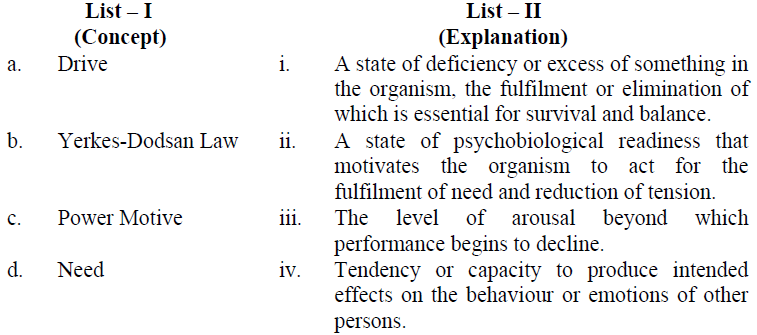
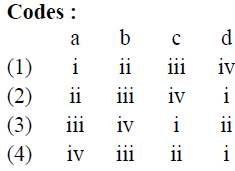
29. Match List – I with List – II and select the correct answer by choosing from the codes given below :
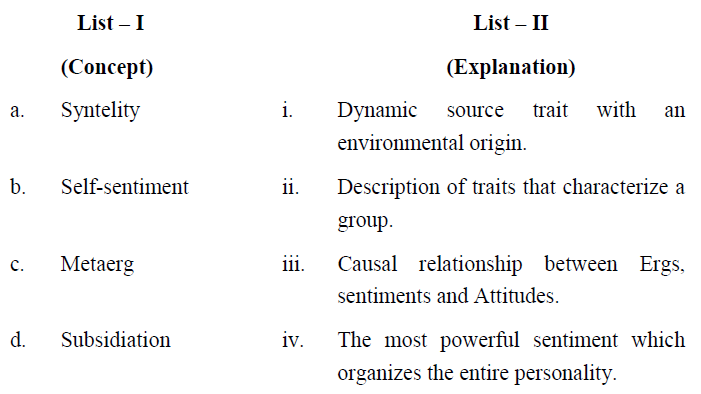
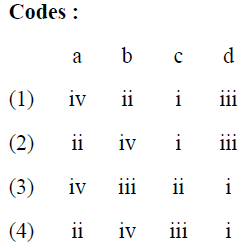
30. 30. Read each of the following two statements – Assertion (A) and Reason (R); and indicate your answer using codes given below :
Assertion (A) : Minor frustrations will add upto produce considerable frustration but not to aggression.
Reason (R) : Disruption of goal-directed behaviour usually leads to frustration.
Codes :
(1) Both (A) and (R) are true, and (R) is the correct explanation of (A).
(2) Both (A) and (R) are true, but (R) is not the correct explanation of (A).
(3) (A) is true, but (R) is false.
(4) (A) is false, but (R) is true.
31. Which of the following are not nuclei of Thalamus ?
(a) Internal Lamina
(b) Anterior Nucleus
(c) Ventromedial Nucleus
(d) Paraventricular Nucleus
Codes :
(1) (a) and (b) only
(2) (b) and (c) only
(3) (c) and (d) only
(4) (a) and (c) only
32. Short-term memory holds information for
(a) 50 seconds
(b) 30 seconds or less
(c) more than 60 seconds
(d) between 50 and 60 seconds
Codes :
(1) (c) only
(2) (a) only
(3) (b) only
(4) (a) and (d)
33. Match List – I with List – II and select the correct answer by choosing from the codes given below :
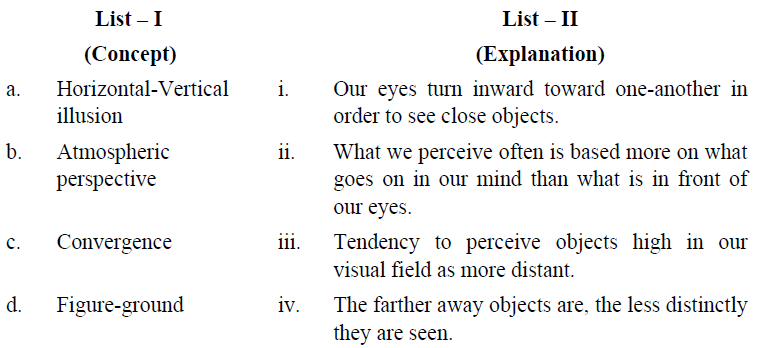

34. Read each of the following two statements – Assertion (A) and Reason (R); and indicate your answer using codes given below :
Assertion (A) : Participants of a study were shown novel geometric shapes that served as targets. Then they were shown fragments of these shapes. Participants were quicker to recognize the fragments as part of the original target.
Reason (R) : We do not use Gestalt principles in our everyday perception.
Codes :
(1) Both (A) and (R) are true, and (R) is the correct explanation of (A).
(2) Both (A) and (R) are true, but (R) is not the correct explanation of (A).
(3) (A) is true, but (R) is false.
(4) (A) is false, but (R) is true.
35. In problem solving if you follow rules that reduce the number of operations or allow you to take short cuts, you are using :
(1) Algorithm
(2) Heuristic
(3) Strategy (4) Skill
36. Anticipation Method can be used in
(a) Free Recall
(b) Serial Learning
(c) Verbal Discrimination
(d) Paired Associates Learning
Codes :
(1) (a), (b) and (c) only
(2) (b), (c) and (d) only
(3) (a) and (b) only
(4) (b) and (d) only
37. Gestalt Psychologist Max Wertheimer attempted to train children to think in a logical and systematic way where he used several figures such as
(a) Squares and rectangles
(b) Parallelogram
(c) Triangles
(d) Circles
Codes :
(1) (a) & (b) only
(2) (b) and (c) only
(3) (c) and (d) only
(4) (a), (b) and (c) only
38. Which of the following sequence describes the energy mobilization in body ?
(1) Fasting phase → Absorptive phase → Cephalic phase
(2) Cephalic phase → Absorptive phase → Fasting phase
(3) Absorptive phase → Fasting phase → Cephalic phase
(4) Fasting phase → Cephalic phase → Absorptive phase
39. According to Bandura, which of the following cognitive mechanisms are adopted by a person to act contrary to his or her moral principles without experiencing self-contempt :
(a) Moral justification
(b) Dehumanization
(c) Displacement of Responsibility
(d) Diffusion of Responsibility
Codes :
(1) (a), (b) and (c) only
(2) (a), (b) and (d) only
(3) (b), (c) and (d) only
(4) (a), (b), (c) and (d)
40. In Guilford’s struct of Intellect Model, obtained abilities have been named in which of the following sequence :
(1) Operations, contents, products
(2) Operations; products; contents
(3) Contents; operations; products
(4) Products; contents; operations
41. Read each of the following two statements – Assertion (A) and Reason (R); and indicate your answer using codes given below :
Assertion (A) : Differences between intelligence levels of monozygotic twins are attributed to environmental influences.
Reason (R) : Monozygotic twins have identical genetically determined reaction range.
Codes :
(1) Both (A) and (R) are true, and (R) is the correct explanation of (A).
(2) Both (A) and (R) are true, but (R) is not the correct explanation of (A).
(3) (A) is true, but (R) is false.
(4) (A) is false, but (R) is true.
42. Match List – I with List – II and select the correct answer by choosing from the codes given below :


43. Information in short-term memory enters long-term storage through
(1) selective attention
(2) elaborate rehearsal
(3) learning
(4) information-processing
44. Read each of the following two statements – Assertion (A) and Reason (R); and indicate your answer using codes given below :
Assertion (A) : A neural membrane is double-layered.
Reason (R) : Lipid molecules turn their tails toward each other.
Codes :
(1) Both (A) and (R) are true, and (R) is the correct explanation of (A).
(2) Both (A) and (R) are true, but (R) is not the correct explanation of (A).
(3) (A) is true, but (R) is false.
(4) (A) is false, but (R) is true.
45. The inputs from our sensory receptors are structured by
(1) Selective principles
(2) Gestalt principles
(3) Analytical principles
(4) Learning principles
Instructions for Questions 46 to 50 :
Read the following paragraph and answer the five questions which follow :
A researcher working in the area of human intelligence wanted to develop a new verbal test of intelligence. For this purpose, he wrote 200 objective multiple-choice items. Each item had four alternatives, one of which was right and the three remaining ones were wrong. He administered this initial version to a sample of 400 subjects. Using P27 and P73 as the cut-off points, he obtained two groups – Low Scoring and High Scoring respectively. The item difficulty index and the item discrimination index were computed for each of the 200 items. To assess whether each item significantly discriminates between Low scoring and High scoring groups, appropriate statistical significance tests were also employed. This item analysis process retained 150 items. The final version of 150 items
was administered to a fresh sample of 750 subjects. The appropriate measures of internal consistency reliability were obtained. The test norms were developed using normalized T scores (mean = 100, SD = 20) and the Wechsler type deviation IQ scores. To assess the dimensionality of verbal intelligence, the researcher also carried out the factor analysis of item scores.
46. Which one of the following test of statistical significance can be employed in the above study to evaluate whether the item significantly discriminates between the Low scoring and High scoring groups ?
(1) Chi-square
(2) Point-biserial correlation
(3) t test
(4) Biserial correlation
47. Which of the following reliability coefficients can be computed in the above study to assess the internal consistency ?
(a) Odd-even reliability coefficient
(b) Kuder-Richardsen reliability coefficient
(c) Cronbach alpha coefficient
(d) Interscorer reliability coefficient
Codes :
(1) (a) only
(2) (a) and (c) only
(3) (a), (b) and (c) only
(4) (b), (c) and (d) only
48. For the above test, what is the expected percentile rank for the T score of 120 ?
(1) 60
(2) 68
(3) 75
(4) 84
49. For the above test, a T score of 80 would correspond to the deviation IQ of
(1) 68
(2) 80
(3) 85
(4) 115
50. In the above study, which type of correlations can be employed to carry out the factor analysis of the test items ?
(1) Biserial correlations
(2) Phi coefficients
(3) Point biserial correlations
(4) Rank order correlations
Latest Govt Job & Exam Updates: